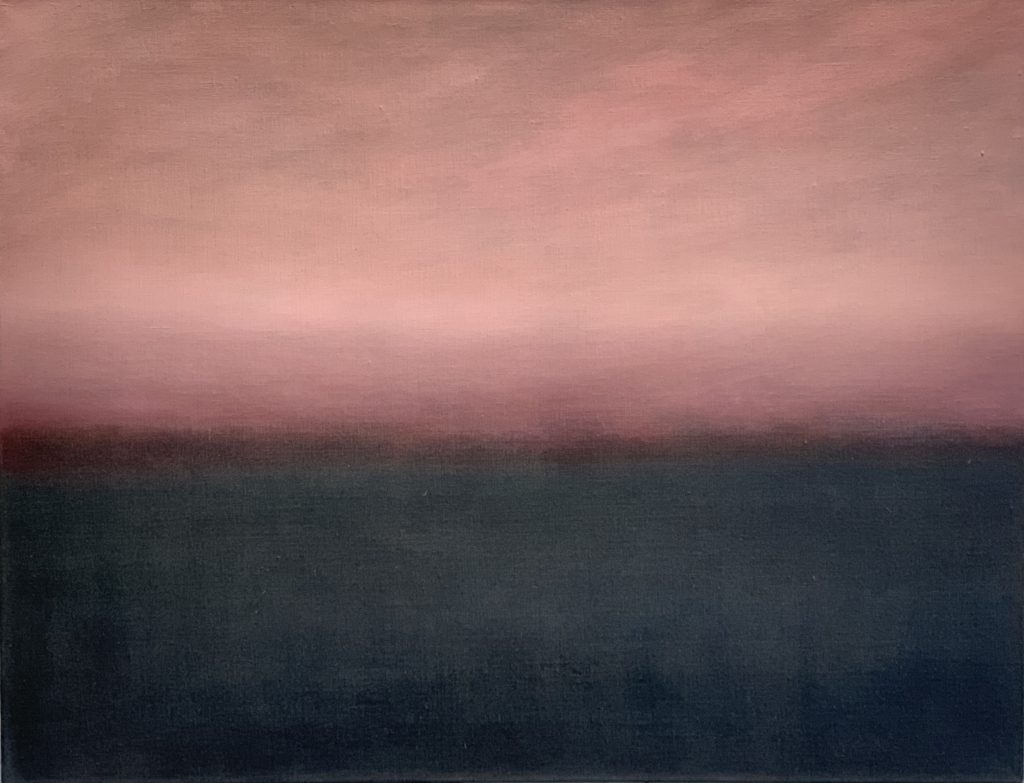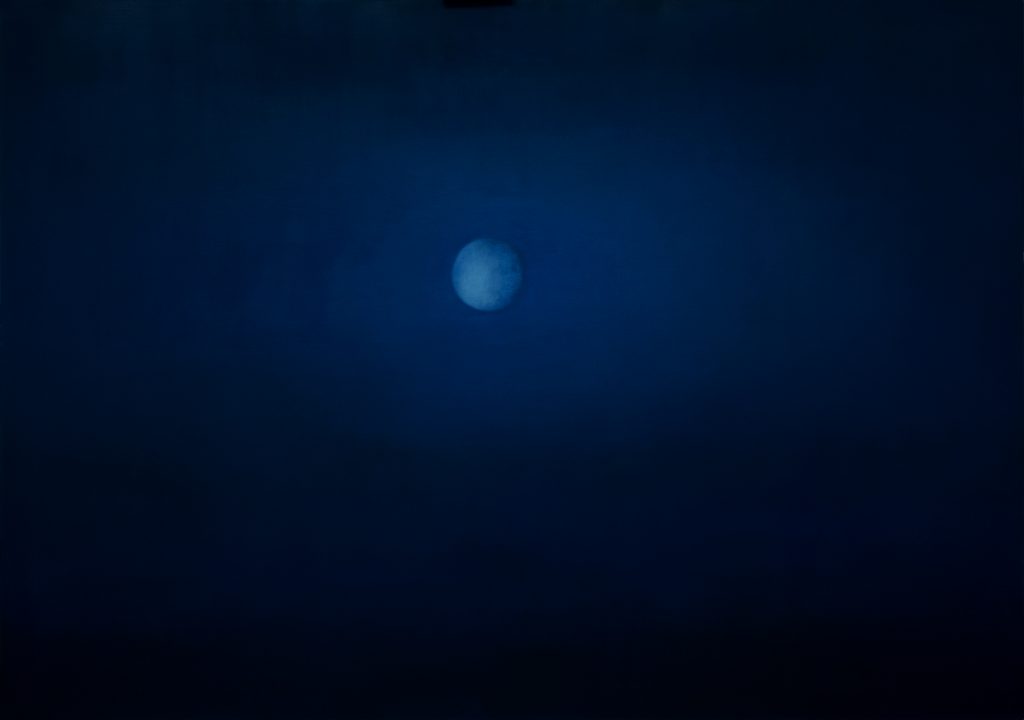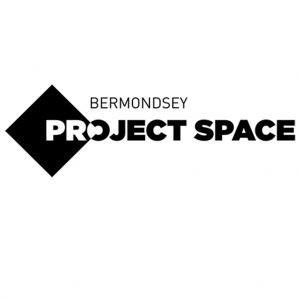Beyond the Shorelines
15 – 26 November 2022

Horizon Series 1 #4
“To me, my paintings are as though sounds and colours interconnect and occur in the space of the canvas at the same time, like a spiral of space-time happening…..“
-Claudia de Grandi
Claudia is a transnational artist concerned with how artists address identity and the modern mind. She grew up in São Paulo with a Brazilian mother and Italian father and has lived in Britain for over 20 years. Sao Paolo is also home to the largest Japanese diaspora in the world, since the first wave of immigration in 1908. It was inevitable that after studying the history of Japanese and Brazilian modernism Claudia would succumb to the spell of Japanese calligraphy and allow it to harness her flow and discipline her mind.
Her large canvases are a process of application and removal, colour on colour, mark making and minimalism. “I might start a painting with a very thin dark layer like black, I will brush it away until it is transparent, and I carry on removing until there’s nothing, then I apply a blue. Applying and removing. I want the viewer to see the colours. At first sight the paintings might seem minimal, but there is a lot going on. There are colours that merge and there are many colours beneath the darkness.”

CLAUDIA DE GRANDI: From Loneliness to Infinity
By Stephen Newton
Claudia De Grandi was born in Sao Paulo. Last year she returned to her ‘beautiful Brazil’ and remarked that ‘I can see and observe again the culture of my birth with completely different eyes as I get older and wiser! I love the contrast of cultures you get here, all cooperating and tolerating each other in great harmony – a good model for the world’. She not only basked in the warmth of the culture but also in the warmth of the climate, stating to me on her return that it is ‘so cold here’.
One might conjecture why a painter would want to discard the warmth of Brazil in order to paint here in England, often a cold, grey and detached place. Van Gogh went south to Arles, Gauguin to Tahiti, but De Grandi chooses England. The icy cerulean blue sky of a northern island is a sky where the air is very often too thin to hold warmth. The sea is an agitated grey sea, which in the changing climate of these times can be threatening. But of course, this is the very point, because here we have painting which is lonely, cold and remote, evoking a sense of deep emptiness and endless space like the cold universe, broken up only by a shifting, restless sea, or transient clouds across the moon. (Fig. 1 – grey moon painting). In essence it confronts the elemental, the infinite, the eternal – and the abyss of infinity is always black, cold and fearful. It must be the case that this painting has more in common with an anxious cold sea and an empty sky than it ever would with a warm blue sea and sun-enveloped sky.
Waves, distant horizons, the moon: an ambiguous veil of the elements in emptiness. What De Grandi ultimately craves is abstraction, her subject and figuration ruthlessly pared down to the edge of extinction. What she has done as a painter is to have absorbed all that pure abstract painting of the past has had to offer and then to return it to a world of reality and to incorporate real elements whilst still fundamentally retaining complete abstraction. Andy Warhol described the ocean as ‘the greatest work of abstract art’ and De Grandi would empathise deeply with such a perspective and her painting reflects how the elemental real is purely abstract. Her paintings are infused with this abstract reality and ultimately she pays homage to those great abstract painters of its golden era: Mark Rothko, Philip Guston, Jackson Pollock. Rothko’s stark abstract horizons metamorphose here into real horizons which still retain a pure abstraction.
See for example Waves & Horizons – Graphite # 12. 2019. (oil and graphite on aluminium, 50x50cm), Fig.2. The only hint that this is in fact a ‘real’ horizon is the delicate, barely perceptible light shimmering on the blackness of the sea. A dark, meditative, contemplative abstraction, which becomes elemental and infinite upon engagement. The viewer is lost in its emptiness and mystical dimension. Here we are on the very edge of reality with only the most minimal indication that we are not lost and engulfed in pure abstraction.
Pays homage to pure abstraction yes, but in her own unique way has employed the abstract creative process to evolve and distil the remote figurative elements of a real world. De Grandi does indeed crave abstraction, but in essence it is the oceanic dimension underlying all abstraction that she yearns to encounter, for it is only here that she can face her own deep isolation, loneliness and alienation. She instinctively understands that only within this dimension lies the potential for a rebirth of a transformed self – a psychic ‘death’ and ‘resurrection’. But as the renowned French writer and mystic Romain Rolland asked of the great guru Ramakrishna: ‘There is no difficulty in approving the apparent destruction of his whole mental structure, and the disintegration of its elements. But how were they reassembled into a synthetic entity of the highest order’?
This is indeed the question: how can the mind of the painter, or the receptive viewer, be deconstructed and then at the deepest level of the abstract painterly process, be magically reconstructed, reintegrated and finally ‘reintrojected’, or internalised as a radically reconstituted mental structure. A psychic transformation understood for centuries past by worldwide tribal cultures whose universal ritual procedures fulfilled this exact objective in transporting the initiate onto a higher mental level in the social group. At the ritual’s core is a trance experience during which time the conscious mind is neutralised. The self-same operation can potentially be enacted within the essence of abstract painting’s creative process. At its heart is encountered the oceanic dimension where all boundaries vanish in a total loss of self and momentarily even of consciousness.
The painter experiences within this oceanic pictorial space a feeling of total omnipotence where every action is effortless and successful. This is all possible because the painterly process in abstraction can progressively eliminate all of the concrete elements of definitive shape and line or composition through which the conscious mind negotiates external reality and holds on to it. Once these footholds are removed consciousness within the psychic mirror of the painting faces the illusion of empty infinity and effectively can be closed down. This is what Picasso analysed within cubism and what modern artists brought to the radical cultural experiments of abstract expressionism.
This is also what De Grandi’s painting similarly confronts. In Waves 8 (1st series) 2018. (oils and graphite on canvas, 85x90cm) Fig.3, the abstract pictorial space envelops the viewer in an oceanic immersion. The suppression of the vacuous representatives of the real sea gives rise to an overall abstract composition devoid of those logical and concrete gestalts which would interfere with the painting’s absolute spiritual and poetic power. The viewer is not sidetracked by a reaction to narrative or compositional arrangement, or line and colour, but is immediately absorbed into the artist’s creative action and can be enveloped in a loss of self. Such a painting echoes the creative process of Philip Guston, who like De Grandi could engage the viewer vicariously in the creative act by showing a progressive removal of definitive shape and draws the viewer into the process of painting.
The concept of the oceanic dimension has long been recognised and critically researched. (2) Indeed, as I have indicated, Romain Rolland understood its import and gravity and corresponded at length with Sigmund Freud on the subject. Freud struggled to grasp the concept principally because his theory of religion tended to stop at the father, as is clearly expounded in his Totem and Taboo, whereas the Eastern mystical religions embraced by Rolland all went deeper beyond the father into the oceanic realm of the maternal. As Catholicism also recognised, the oceanic dimension is an exclusively feminine dimension.
It is significant in respect of Claudia De Grandi’s creative process that Rolland was a professor of the history of music at the Sorbonne, who wrote a biography of Beethoven and also a long novel on the life of an imaginary German composer, which won him a Nobel prize in 1915. (3) For De Grandi is a classically trained pianist who as with Rolland empathises with music as an abstraction – and music is the ultimate abstract art form. It is no surprise therefore that she regards it as her ‘inspirational undercurrent’ – and undercurrent of course implies the ocean and in abstract music, the oceanic.
De Grandi’s paintings pay constant homage to the oceanic dimension. In this amongst other painters who have strived towards the same objective she is not alone. Rothko was well aware of this esoteric domain and of its potential ecstatic nature. It should be noted that the Greek root of ecstatic – ekstasis – means ‘out-of-body’. Dore Ashton relates how Rothko encountered the experience but was very unforthcoming about it. (4). Furthermore there is in today’s contemporary culture an ongoing struggle to appropriate the oceanic and contemporary conceptual artists such as Bill Viola and Susan Hiller try to re-enact the oceanic psychic immersion in installation pieces and performance art. But in truth such artists only succeed in simulating the experience as in a mannerism. (5)
It is the case today that abstract painting has lost its soul – its inner spiritual life’s blood. Contemporary abstract painting is very often decorative mannerism and ornament. The same can be said of what is left of ritual, which has degenerated into a soulless ceremonial, enacted for tourists, just as the tribal sculpture has become a curio or tourist piece. The New York critic and pre-eminent psychoanalytic theorist of art Donald Kuspit recently asked this very pertinent question:
‘Suppose, as I think, 20th century abstract art has by and large lost its creative depth and become an academic mannerism: an illustration of the idea of spiritual pictorial space rather than its ecstatic substance. Then the question art faces – at least for art eager to serve and “substantiate” the spiritual unconscious – is how to sustain spirituality without its abstract mode of articulation. More simply how can spirituality be made to seem credible when the abstract art that has been its modern vehicle has become shopworn and outworn, that is, old?’ (6)
I think that De Grandi’s painting offers profound answers to this question, for as I have indicated it remains fundamentally abstract like music and as such has critically reconstituted the spiritual essence of the origins of abstract painting and further to this reveals how elemental abstraction distils an elemental figuration. In other words De Grandi’s minimalist iconography is set within an infinite abstract oceanic space which has carried her work beyond pure abstract painting and into a re-contextualised position where the lost spirituality of the abstract painting is resurrected.
For abstraction in painting to reconnect with its spiritual source in the deepest oceanic level of the unconscious mind, objects seem to be required: radically distilled objects evolved from the creative unconscious. Such painting is post-abstract whilst retaining in essence an abstract substructure. Minimalist, sparse objects recast the abstract setting and revitalise its spiritual essence removed from the degraded mannerism of what Donald Kuspit described as ‘shopworn’ abstraction.
Claudi De Grandi I believe unconsciously connects with this aspiration in contemporary painting. She suppresses narrative and any reference to the real world to the very edge of pure abstraction and in this act of suppression conscious control must be circumvented or even extinguished. Her creative painting process is founded on the unconscious, of denial of control and this is ultimately what facilitates the painting’s connection with Kuspit’s ‘spiritual unconscious’.
This critical edge of pure abstraction in its tenuous relationship with distant icons of reality can be seen to an extreme in paintings such as Horizon 4 (1st series), 2017. (oil on canvas, 67x87cm) Fig.4. Here the faintest allusion to a ‘reality’ can hardly be detected, serving only to give prominence to the oceanic power of the abstract element. It can readily be seen why Alan Rankle would draw a comparison between De Grandi’s paintings and the absolute black paintings of Ad Reinhardt. (7) Likewise the painting Horizon 2, 1.3.2017, (oils on linen, 150x135cm) Fig.5, pays direct homage to Rothko. But again with the underlying paradox that the abstract painting is again overlaid with an element of De Grandi’s real world.
Claudia De Grandi is to be congratulated on her achievement in the depth of her understanding of abstract painting and her transformation of radical abstract art into a contemporary mode of painting which returns it to reality. Her work is certainly poetic, certainly spiritual, certainly musical and deeply moving. But further to this it provides very important ways forward for such painting, beyond the deterioration of abstract painting into academic mannerism and into an authentic deeply emotional abstracted painting of great power.
NOTES
(1) Romain Rolland. The Life of Ramakrishna (Calcutta: Advaita Ashrama, 1997). P.19
(2) Melanie Klein defined the omnipotent phase in infant development, a phase which corresponds with the oceanic phase. The most important theorist of the oceanic is Anton Ehrenzweig who critically recognised that the oceanic phase was the fulcrum of the creative process. He designated it as the ‘manic-oceanic’. See his works: The Psycho-Analysis of Artistic Vision and Hearing: An introduction To a Theory of Unconscious Perception (London: Routledge and Kegan Paul, 1953) and The Hidden Order of Art (Berkeley and Los Angeles: University of California press, 1967).
(3) Romain Rolland. Jean-Christophe 1904-12.
(4) Dore Ashton. About Rothko (New York: Da Capo Press, 1996).
(5) See for example Susan Hiller’s Witness (2000) and Bill Viola’s Five Angels for the Millenium (2001).
(6) Donald Kuspit. The Post-Modern Icon in Art and Ritual (London and Argenterie: Ziggurat Books International, 2008), p.3
(7) Alan Rankle. Catalogue essay in Claudia De Grandi – Waves and Horizons (Riverfall Press, 2020) pp. 9-15.
